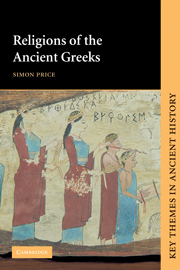Book contents
- Frontmatter
- Contents
- List of figures
- Preface
- List of abbreviations
- 1 Introduction
- 2 Gods, myths and festivals
- 3 Religious places
- 4 Authority, control and crisis
- 5 Girls and boys, women and men
- 6 Elective cults
- 7 Greek thinkers
- 8 Reactions to Greek religions
- Appendix of Greek inscriptions in translation
- Bibliographical essay
- Bibliography
- Index
- Frontmatter
- Contents
- List of figures
- Preface
- List of abbreviations
- 1 Introduction
- 2 Gods, myths and festivals
- 3 Religious places
- 4 Authority, control and crisis
- 5 Girls and boys, women and men
- 6 Elective cults
- 7 Greek thinkers
- 8 Reactions to Greek religions
- Appendix of Greek inscriptions in translation
- Bibliographical essay
- Bibliography
- Index
Summary
Greek temples are among the most familiar surviving objects of antiquity. Thousands of visitors a year gaze at the Parthenon, and the influence of the temples, direct or indirect, is visible all the way from the White House in Washington DC to the Opera House in Ulan Bator, Mongolia. In antiquity too they were prestigious buildings. Architects around the Greek world rivalled one another in building bigger and finer temples, and cities were extremely proud of their religious architecture. Herodotos, who was fond of Samos, includes the temple of Hera there among the three architectural wonders that justified his writing at length about the Samians (the other two were an aqueduct one kilometre long through a mountain, and a harbour mole) (3.60). This temple of Hera on Samos was planned in the earlier sixth century bc on a colossal scale and, a generation later, probably because of marshy conditions, rebuilt on a similar scale. Work continued for the next five hundred years until hope of actually completing the temple was abandoned, but the temple was still an impressive sight. Bronze coins produced by Greek cities in the Roman period often feature their temples as matters of local pride; for example, coins of Samos from the first to the mid-third centuries ad proudly display the ancient cult statue of Hera in its temple.
- Type
- Chapter
- Information
- Religions of the Ancient Greeks , pp. 47 - 66Publisher: Cambridge University PressPrint publication year: 1999



